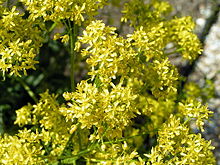Isatis
| Isatis | |
|---|---|

| |
| Isatis tinctoria | |
| Scientific classification | |
| Kingdom: | Plantae |
| Clade: | Tracheophytes |
| Clade: | Angiosperms |
| Clade: | Eudicots |
| Clade: | Rosids |
| Order: | Brassicales |
| Family: | Brassicaceae |
| Genus: | Isatis L. |
| Species | |
|
About 30 species, including: | |
| Synonyms[1] | |
|
List
| |
Isatis is a genus of
woad (Isatis tinctoria). Due to their extremely variable morphology, the Asian species in particular are difficult to determine; the only reliable diagnostic feature is the ripe fruit. They are (usually) biennial or perennial herbaceous plants, often bluish and hairless or downy hairy with the upright stem branched.[2]
Description
They are annual, biennial or perennial, branched herbs, usually
; sessile caulinary, rounded to oval-oblong.The
Racemose
is branched or paniculated, ebracted, inflorescence, often reaching lax and elongated in the fruit.
The fruit is a generally linear silique, oblong-cuneate to suborbicular, indehiscent, flattened laterally, unilocular, little to conspicuously winged, glabrous or with tiny hairs.[3]
Species
Currently accepted species include:[1]
- Isatis afghanica Hadac & Chrtek
- Isatis amani P.H.Davis
- Isatis apennina Ten. ex Grande
- Isatis apscheronica N.Busch
- Isatis aptera (Boiss. & Heldr.) Al-Shehbaz, Moazzeni & Mumm.
- Isatis arenaria Azn.
- Isatis armena L.
- Isatis arnoldiana N.Busch
- Isatis aucheri Boiss.
- Isatis biscutellifolia Boiss. & Buhse
- Isatis bitlisica P.H.Davis
- Isatis boissieriana Rchb.f.
- Isatis brachycarpa C.A.Mey.
- Isatis brevipes (Bunge) Jafri
- Isatis bullata Aitch. & Hemsl.
- Isatis bungeana Seidlitz
- Isatis buschiana Schischk.
- Isatis callifera Boiss. & Balansa
- Isatis campylocarpa Boiss.
- Isatis canaliculata (Vassilcz.) V.V.Botschantz.
- Isatis candolleana Boiss.
- Isatis cappadocica Desv.
- Isatis cardiocarpa (Trautv.) Al-Shehbaz, Moazzeni & Mumm.
- Isatis caucasica N.Busch
- Isatis cochlearis Boiss.
- Isatis constricta P.H.Davis
- Isatis costata C.A.Mey.
- Isatis davisiana H.Misirdali ex P.H.Davis, R.R.Mill & Kit Tan
- Isatis demiriziana H.Misirdali ex P.H.Davis, R.R.Mill & Kit Tan
- Isatis densiflora (Bunge ex Boiss.) D.A.German
- Isatis deserti (N.Busch) V.V.Botschantz.
- Isatis djurjaedae Coss. & Durieu
- Isatis elegans (Boiss.) Hadac & Chrtek
- Isatis emarginata Kar. & Kir.
- Isatis erzurumica P.H.Davis
- Isatis floribunda Boiss. ex Bornm.
- Isatis frigida Boiss. & Kotschy
- Isatis frutescens Kar. & Kir.
- Isatis gaubae Bornm.
- Isatis glastifolia (Fisch. & C.A.Mey.) Al-Shehbaz, Moazzeni & Mumm.
- Isatis glauca Aucher ex Boiss.
- Isatis grammotis Kit Tan
- Isatis gymnocarpa (Fisch. ex DC.) Al-Shehbaz, Moazzeni & Mumm.
- Isatis harsukhii O.E.Schulz
- Isatis hirtocalyx Franch.
- Isatis huber-morathii P.H.Davis
- Isatis iberica Steven
- Isatis jacutensis (N.Busch) N.Busch
- Isatis karjaginii Schischk.
- Isatis kotschyana Boiss. & Hohen.
- Isatis kozlovskyi Grossh.
- Isatis laevigata Trautv.
- Isatis latisiliqua Steven
- Isatis leuconeura Boiss. & Buhse
- Isatis littoralis Steven
- Isatis lockmanniana Kotschy ex Boiss.
- Isatis lusitanica L.
- Isatis mardinensis P.H.Davis & H.Misirdali
- Isatis maxima Pavlov
- Isatis microcarpa J.Gay ex Boiss.
- Isatis minima Bunge
- Isatis multicaulis (Kar. & Kir.) Jafri
- Isatis oblongata DC.
- Isatis odontogera (Bordz.) D.A.German
- Isatis ornithorhynchus N.Busch
- Isatis pachycarpa Rech.f., Aellen & Esfand.
- Isatis pinnatiloba P.H.Davis
- Isatis platyloba Link ex Steud.
- Isatis praecox Kit. ex Tratt.
- Isatis raimondoi Di Grist., Scafidi & Domina
- Isatis raphanifolia Boiss.
- Isatis rugulosa Bunge ex Boiss.
- Isatis sabulosa Steven ex Ledeb.
- Isatis sevangensis N.Busch
- Isatis sivasica P.H.Davis
- Isatis spatella P.H.Davis
- Isatis spectabilis P.H.Davis
- Isatis steveniana Trautv.
- Isatis stocksii Boiss.
- Isatis subdidyma (N.Busch) V.E.Avet.
- Isatis takhtajanii Avet.
- Isatis tinctoria L.
- Isatis tomentella Boiss. & Balansa
- Isatis trachycarpa Trautv.
- Isatis turcomanica Korsh.
- Isatis undulata Aucher ex Boiss.
- Isatis violascens Bunge
- Isatis zarrei Al-Shehbaz, Moazzeni & Mumm.
References
- ^ a b "Isatis Tourn. ex L." Plants of the World Online. Board of Trustees of the Royal Botanic Gardens, Kew. 2017. Retrieved 13 August 2020.
- ^ H. Moazzeni et al .: Phylogeny of Isatis (Brassicaceae) and allied genera based on ITS sequences of nuclear ribosomal DNA and morphological characters. In: Flora (Elsevier), Volume 205, 2010, pp. 337–343.
- ^ Flora of North America Editorial Committee, e. 2010. Magnoliophyta: Salicaceae to Brassicaceae. Fl. N. Amer. 7: i – xxii, 1–797.
